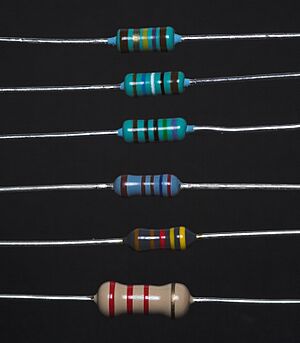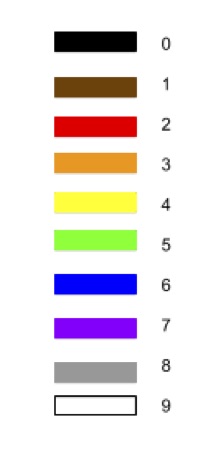Resistor facts for kids
A resistor is a small electronic part that helps control electricity in a circuit. Think of it like a tiny gate that slows down the flow of electric current. This "slowing down" is called resistance. When electrons (tiny particles that carry electricity) pass through a resistor, some of their energy changes into heat or even light. For example, in an old-fashioned light bulb, a special wire called tungsten acts like a resistor. It gets hot and glows, turning the electricity into light.
Contents
How Resistors Connect
Resistors can be connected in different ways to make an electric circuit work just right:
- Series - This is when resistors are linked one after another, like beads on a string.
- Parallel - This is when resistors are linked side-by-side, creating multiple paths for the electricity.
There are many kinds of resistors. They have different ratings that tell electricians how much power they can handle without breaking. They also show how accurately they can slow down electricity. Connecting resistors in series makes the total resistance higher. Connecting the same resistors in parallel makes the total resistance lower. This helps protect other parts of the circuit.
Today, many electronic devices use very tiny resistors called surface-mount technology (SMT) resistors.
Calculating Resistance
When you connect resistors, you can calculate the total resistance:
- Series Circuit: To find the total resistance (Rt) in a series circuit, you just add up the values of all the resistors.
* Rt = R1 + R2 + R3 + ... Rn
- Parallel Circuit: To find the total resistance (Rt) in a parallel circuit, you use a slightly different formula. You add the "inverse" (1 divided by the value) of each resistor, and then take the inverse of that sum.
* 1/Rt = 1/R1 + 1/R2 + 1/R3 + ... 1/Rn * Here, 'R' stands for the value of each resistor.
Understanding Ohm's Law
Ohm's Law is a very important rule in electronics. It helps us understand how voltage, current, and resistance are connected. The main formula is:
- V = I * R
* V stands for Voltage (the "push" of electricity). * I stands for Current (how much electricity is flowing). * R stands for Resistance (how much the flow is slowed down).
You can also change the formula around to find a different value if you know the other two:
- I = V / R (to find current)
- R = V / I (to find resistance)
Resistor Color Code
Resistors often have colored bands on them. These bands are a secret code that tells you the resistor's value! The colors used are black, brown, red, orange, yellow, green, blue, purple, gray, and white. Each color stands for a different number:
- Black = 0
- Brown = 1
- Red = 2
- Orange = 3
- Yellow = 4
- Green = 5
- Blue = 6
- Purple = 7
- Gray = 8
- White = 9
A resistor can have several color bands, usually four, but sometimes up to six. On a common four-band resistor, the last band is usually gold or silver.
- A gold band means the resistor has a "tolerance" of plus or minus 5%. This means its actual resistance is very close to the coded value.
- A silver band means a tolerance of plus or minus 10%.
To read the code, hold the resistor so the gold or silver band is on the right. Then, read the colors from left to right: 1. The first two bands give you the first two numbers of the resistance value. 2. The third band is a "multiplier." It tells you how many zeros to add after the first two numbers. For example, if the third band is orange (which is 3), you multiply the first two numbers by 1,000 (or add three zeros).
What Resistors Are Used For
Resistors are super useful in many ways:
- Protecting Parts: They are put in circuits to protect sensitive parts, like LEDs (light-emitting diodes), from getting too much current and burning out.
- Controlling Current: They control how much current flows in a circuit. If you want to slow down the current, you add more resistors to create more resistance.
- Splitting Voltage: Resistors can also divide the voltage between different parts of a circuit.
- Time Delays: They can even help create time delays in electronic circuits.
What Resistors Are Made Of
You can find many different kinds of resistors. They are all made with a special material that resists electricity, wrapped inside a non-conductive (meaning it doesn't conduct electricity) casing, often plastic. Most common resistors used today are "fixed resistors." They are usually made of carbon inside a plastic cylinder, with a wire coming out of each end to connect them. Older resistors were sometimes made of metal that didn't conduct electricity very well.
Images for kids
-
Three carbon composition resistors in a 1960s valve (vacuum tube) radio
-
An assortment of small through-hole potentiometers designed for mounting on printed circuit boards.
-
Resistance decade box, made in former East Germany.
-
This image shows four surface-mount resistors (the component at the upper left is a capacitor) including two zero-ohm resistors. Zero-ohm links are often used instead of wire links, so that they can be inserted by a resistor-inserting machine. Their resistance is negligible.
See also
 In Spanish: Resistor para niños
In Spanish: Resistor para niños























